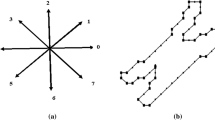Abstract
How to use a polygon with the fewest possible sides to approximate a shape boundary is an important issue in pattern recognition and image processing. A novel split-and-merge technique(SMT) is proposed. SMT starts with an initial shape boundary segmentation, split and merge are then alternately done against the shape boundary. The procedure is halted when the pre-specified iteration number is achieved. For increasing stability of SMT and improving its robustness to the initial segmentation, a ranking-selection scheme is utilized to choose the splitting and merging points. The experimental results show its superiority.
Preview
Unable to display preview. Download preview PDF.
Similar content being viewed by others
References
Rafael, C.G., Richard, E.W.: Digital Image Processing, pp. 648–649. Prentice-Hall, Englewood Cliffs (2002)
Sklansky, J., Gonzalez, V.: Fast Polygonal Approximation of Digitized Curves. Pattern Recognition 12, 327–331 (1980)
Ray, B.K., Ray, K.S.: Determination of Optimal Polygon from Digital Curve Using L 1 Norm. Pattern Recognition 26, 505–509 (1993)
Ramer, U.: An Iterative Procedure for the Polygonal Approximation of Plane Curves. Comput. Graph. Image. Process. 1, 244–256 (1972)
Pikaz, A., Dinstein, I.: An Algorithm for Polygonal Approximation Based in Iterative Point Elimination. Pattern Recognition Letters 16(6), 557–563 (1995)
Yin, P.Y.: Genetic Algorithms for Polygonal Approximation of Digital Curves. Int. J. Pattern Recognition Artif. Intell. 13, 1–22 (1999)
Goldberge, D.E.: Genetic Algorithms in Search, Optimization and Machine Learning. Addison-Wesley, Reading (1989)
Baker, J.F.: Adaptive Selection Methods for Genetic Algorithms. In: Grefenstette, J.J. (ed.) Proc. of the 1st Int’1. Conf. on Genetic Algorithms, pp. 101–111. Lawrence Earlbaum Associates, Hilladale, NJ (1985)
Teh, H.C., Chin, R.T.: On Detection of Dominant Points on Digital Curves. IEEE Trans. Pattern Anal. Mach. Intell. 11(8), 859–872 (1989)
Author information
Authors and Affiliations
Editor information
Editors and Affiliations
Rights and permissions
Copyright information
© 2006 Springer-Verlag Berlin Heidelberg
About this paper
Cite this paper
Wang, B., Shi, C. (2006). A Novel Split-and-Merge Technique for Error-Bounded Polygonal Approximation. In: King, I., Wang, J., Chan, LW., Wang, D. (eds) Neural Information Processing. ICONIP 2006. Lecture Notes in Computer Science, vol 4233. Springer, Berlin, Heidelberg. https://doi.org/10.1007/11893257_37
Download citation
DOI: https://doi.org/10.1007/11893257_37
Publisher Name: Springer, Berlin, Heidelberg
Print ISBN: 978-3-540-46481-5
Online ISBN: 978-3-540-46482-2
eBook Packages: Computer ScienceComputer Science (R0)




